Genetic diversity of Springtails (<i>Collembola Subclass</i>) Based on Cytochrome oxidase Subunit I (COI) Genes in Malang
DOI:
https://doi.org/10.21776/ub.biotropika.2022.010.01.09Abstract
The springtails belongs to the Collembola subclass of the insect class. Springtails is a mesofauna insect that acts as a detritivore and bio-indicator in ecosystem. Genetic diversity is influenced by the total amount of genetic variation present in the genes coding for a species or organism. COI gene is a gene that is useful as a genetic marker for mitochondrial DNA. The genetic diversity of springtails based on mtDNA COI gene sequences is not widely known in Indonesia. Based on this, this study aims to reveal the genetic diversity of springtails in Malang. This research was conducted by 3 locations in Malang (Cangar, Bedengan and Tambakasri). Measurements of the microclimate (humidity and air temperature) and altitude measurements were carried out at springtails sampling site, then carried out the DNA isolation process from the springtails samples obtained, the COI amplification process and sequencing were carried out. After obtaining the sequence data, genetic diversity analysis and polymorphism analysis were carried out. The results of this study were the target genes amplified from all samples of spring tails with DNA fragments along 677-683 bp. The sample of springtails had a genetic identity match with Homidia socia Denis and Homidia cingula Börner based on the BLAST analysis, results of genetic diversity analysis showed that the samples tested had high genetic diversity, composition of nucleotide bases A/T was 60,8%, genetic variation in the form of transition substitution (87 sites) and transversion (55 sites), and the results of polymorphism analysis showed the value of 0,18201 nucleotide diversity, number of segregation was 162 sites and sequences conservation was 0,744.
Downloads
Published
Issue
Section
License
Copyright and Attribution:
Articles in Biotropika: Journal of Tropical Biology are under Creative Commons Attribution-NonCommercial (CC-BY-NC) copyright. The work has not been published before (except in the form of an abstract or part of a published lecture or thesis) and it is not under consideration for publication elsewhere. When the manuscript is accepted for publication in this journal, the authors agree to the automatic transfer of the copyright to the publisher.
![]() Journal of Biotropika: Journal of Tropical Biology is licensed under a Creative Commons Attribution-NonCommercial 4.0 International (CC BY-NC 4.0).
Journal of Biotropika: Journal of Tropical Biology is licensed under a Creative Commons Attribution-NonCommercial 4.0 International (CC BY-NC 4.0).
Permissions:
Authors wishing to include figures, tables, or text passages that have already been published elsewhere and by other authors are required to obtain permission from the copyright owner(s) for both the print and online format and to include evidence that such permission has been granted when submitting their papers. Any material received without such evidence will be assumed to originate from one of the authors.
Ethical matters:
Experiments with animals or involving human patients must have had prior approval from the appropriate ethics committee. A statement to this effect should be provided within the text at the appropriate place. Experiments involving plants or microorganisms taken from countries other than the author's own must have had the correct authorization for this exportation.

















